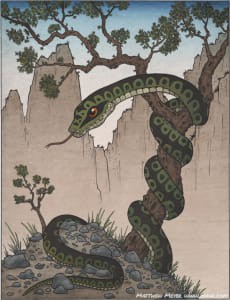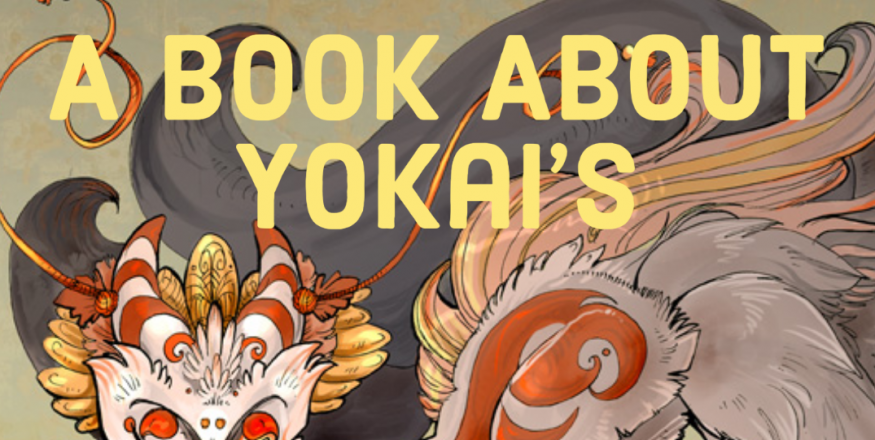 x
x
"蟒蛇"555Please respect copyright.PENANAEyEmb5ek1i
"うわばみ"
Translation: giant snake, great serpent555Please respect copyright.PENANACROn3TqlQB
Alternate names: orochi, daija555Please respect copyright.PENANA7h0psL1z7h
Habitat: wilderness555Please respect copyright.PENANAFfoN93d63X
Diet: carnivorous, very fond of alcohol; gluttonous
Appearance: Uwabami are enormous serpents. Apart from their incredible size, they closely resemble ordinary snakes. They make their homes in the wilderness, far from civilization.
Behavior: Uwabami’s most notable feature is their appetite. They are capable of eating things that are much larger than their bodies, and in quantities that seem like more than they should be able to eat. They are also extremely fond of drinking, and can consume huge quantities of sake. Like many animals, snakes are believed to have a variety of magical powers. They can shape-shift into various objects and creatures, including humans. They can even control the elements to some extent. Natural disasters such as floods and rock slides are often attributed to uwabami.
Interactions: In addition to eating large volumes of food and alcohol, uwabami also like to feed on people. They set up ambushes and assault travelers in mountain passes. Because of their size, they can easily swallow a full grown human whole—and they often do. However, they are sometimes outsmarted by clever people, who live to tell others of what they saw.
Origin: Snakes have been a part of Japanese mythology since the earliest times, in part to their peculiar behaviors. Snakes are symbols of life and death, and eternal youth—the shedding and regrowing of their skin was viewed as a magical ability. Because they can slip into the tiniest cracks, and can penetrate deep, dark places that are inaccessible to humans, they are viewed as tenacious and clever creatures. Because of these traits, snakes have long been considered to be kami or yōkai. During different periods of history, they have been referred to as orochi, daija, and uwabami, but all of these refer to the same creature.
The name uwabami has roots going back to archaic Japanese. The first part of the name, uwa, meant skillful or superior. Gradually this shifted to a similar sounding word, uha, which meant great or large. The second part of the name is from an archaic word for snake, hami. This word derives from the word for eating, hamu, which refers both to the snake’s fondness for biting and its ability to eat things that appear much larger than it. So uwabami were “skillful eaters” which over time became “giant snakes.”
Another linguistic point of interest is that the word “uwabami” also has the colloquial meaning of “heavy drinker.” The reason for this is the uwabami’s great love for sake and its ability to drink in far alcohol more than even a creature as large as it should be able to.
Legends: A famous tale comes from Ōnuma Lake in Nagano Prefecture.
Long ago, there was an daija who lived in Ōnuma Lake. Every year he would transform into an extremely handsome young man and travel to the eastern mountains to view the cherry blossoms. One spring, he spied a beautiful young woman all by herself under the blossoms. The woman was Kuro hime, the daughter of Takanashi Masamori, a powerful lord of Shinano Province. Kuro hime also spied the handsome man who was watching her and found him irresistable. The two became acquainted and soon fell in love.
Some time later, the handsome young man paid a visit to the castle of Takanashi Masamori. He introduced himself as the great snake who lives in Ōnuma Lake, guardian deity of the Shiga Highlands. He explained that he and Kuro hime were in love, and asked the lord for her hand in marriage. Masamori immediately snapped that he would never give his daughter to someone that was not human.
The young man did not give up, and returned day after day to ask for Kuro hime’s hand in marriage. Finally, the lord relented and gave his conditions: “If you can keep up with me on horseback and complete seven laps around my castle, I will give you my daughter.” The young man eagerly accepted and agreed to return to the castle in a few days for the race.
Masamori was not about to let his daughter marry a snake. He devised a plan to kill the creature so it would leave him and his daughter alone forever. He had his servants plant swords in the grass all around the castle. Masamori was an expert rider and knew where the swords were hidden, so he would easily be able to avoid the traps.
When the day of the race came, the young man showed up at the castle as promised. The race began, and Takanashi Masamori spurred his horse into action. He was indeed an expert rider, and the young man could not keep up with the lord. He had to transform back into a snake in order to keep pace with the horse. The swords planted around the castle perimeter pierced and tore the snakes body, but he did not give up. Finally, the lord and the snake completed their seven laps. The snake’s body was ragged, and rivers of blood flowed from his body. Immediately upon finishing his final lap, the daija collapsed. Masamori’s trap had worked.
After some time had passed, the daija awoke. It looked around, and seeing nobody it realized that Masamori had lied. Trembling with rage, the daija returned to the Shiga Highlands. It summoned all of its family, servants, and clan members. All of the spirits of the Shiga Highlands arose and summoned a great storm. Rain the likes of which had never been seen before fell. Ōnuma Lake swelled in size and burst forth, flooding everything around. All of the villages surrounding the lake were annihalated. Houses were knocked down. Fields were flooded and washed away. No humans or animals were able to escape destruction. However, the mountains around the Takanashi Masamori’s castle acted like a shield, and the castle stood firm.
Kuro hime looked down from the castle and watched the torrent wash away wash away the entire region. She heartbroken when she saw the destruction. Realizing that only she had the power to stop the disaster, she left the castle by herself and traveled down to Ōnuma Lake. Kuro hime threw herself into the flood and was never seen again. When the daija realized what had happened, it immediately scattered the storm clouds and caused the flood to recede. Ōnuma Lake shrank back to its original borders.
The daija is still worshiped today as the guardian deity of the Shiga Highlands. There is a small shrine called Daija Jinja located near Ōnuma Lake where the snake is enshrined. Every August, the villagers gather there to perform the Daija Matsuri and remember the story of Kuro hime.
ns 15.158.61.11da2





















